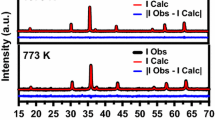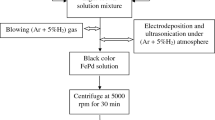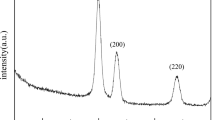Abstract
In the present work, the FeNi nanoparticles have been synthesized using NaBH4 reduced co-precipitation technique followed by annealing at 210 °C for 4 h in a simple box furnace. The nanoparticles were characterized using X-ray diffraction (XRD), Field emission scanning electron microscopy (FE-SEM), Energy-dispersive X-ray spectroscopy (EDS), Raman spectroscopy, and dc magnetization. The XRD analysis revealed the formation of dual phases (FeNi3; FeNi) with face-centred cubic symmetry along with the additional phases of oxonium Ni oxide (NiOOH), hexagonal-Fe and iron peroxide (FeOOH). The FE-SEM micrographs demonstrated the evolution of dumb-bell shape morphology due to the heterogeneous growth of the nuclei resulting into agglomeration of particles. The XRD and FE-SEM collectively confirmed the nanometre (nm) dimensions of the particles. The mapping performed using EDS spectra validates the elemental compositions of the Nanoparticles. The Raman spectra reiterated the presence of impurity phases in addition to the trivial amount of NiO. The M–H (field dependent magnetization) hysteresis curves, plotted under the conditions of field cooled (FC) and zero field cooled (ZFC), shifted horizontally by ~ 14Oe indicating presence of exchange bias. Alongside, FC-ZFC MT (temperature-dependent magnetization) curves also showed bifurcation at temperatures below 300 K that is also an indicative to the exchange bias. In brief, the exchange bias has been confirmed in ferromagnetic FeNi nanoparticles and the origin may be attributed to the exchange interactions at the particle interfaces having canted spins which emerge due to the presence of impurities and dual phases of FeNi.






Similar content being viewed by others
References
Anumol EA, Kundu P, Deshpande PA et al (2011) New insights into selective heterogeneous nucleation of metal nanoparticles on oxides by microwave-assisted reduction: rapid synthesis of high-activity supported catalysts. ACS Nano 5:8049–8061. https://doi.org/10.1021/nn202639f
Balan A, Derlet PM, Rodríguez AF et al (2014) Direct observation of magnetic metastability in individual iron nanoparticles. Phys Rev Lett 112:107201. https://doi.org/10.1103/PhysRevLett.112.107201
Çakir A, Acet M, Farle M (2016) Exchange bias caused by field-induced spin reconfiguration in Ni-Mn-Sn. Phys Rev B 93:094411. https://doi.org/10.1103/PhysRevB.93.094411
Chen PC, Liu M, Du JS et al (2019) Interface and heterostructure design in polyelemental nanoparticles. Science 363:959–964
Cole KM, Kirk DW, Thorpe SJ (2018) In Situ Raman study of amorphous and crystalline Ni-Co alloys for the alkaline oxygen evolution reaction. J Electrochem Soc 165:J3122–J3129. https://doi.org/10.1149/2.0131815jes
Diaz-Morales O, Ferrus-Suspedra D, Koper MTM (2016) The importance of nickel oxyhydroxide deprotonation on its activity towards electrochemical water oxidation. Chem Sci 7:2639–2645. https://doi.org/10.1039/c5sc04486c
Dos Santos CM, Martins AFN, Costa BC et al (2016) Synthesis of FeNi alloy nanomaterials by proteic Sol-Gel method: crystallographic, morphological, and magnetic properties. J Nanomater 2016:9. https://doi.org/10.1155/2016/1637091
Ghosh A, Paul S, Raj S (2015) Understanding bifurcations in FC-ZFC magnetization of dilutely Fe3+ doped CdS nanoparticles. Solid State Commun 208:1–6. https://doi.org/10.1016/j.ssc.2015.02.010
Giri S, Patra M, Majumdar S (2011) Exchange bias effect in alloys and compounds. J Phys Condens Matter 23:073201. https://doi.org/10.1088/0953-8984/23/7/073201
Glavee GN, Klabunde KJ, Sorensen CM, Hadjapanayis GC (1992) Borohydride reductions of metal ions. a new understanding of the chemistry leading to nanoscale particles of metals, borides, and metal borates. Langmuir 8:771–773. https://doi.org/10.1021/la00039a008
Ho RYN, Roelfes G, Feringa BL, Que L (1999) Raman evidence for a weakened O-O bond in mononuclear low-spin iron(III)-hydroperoxides. J Am Chem Soc 121:264–265. https://doi.org/10.1021/ja982812p
Hong LB, Fultz B (1996) Two-phase coexistence in Fe-Ni alloys synthesized by ball milling. J Appl Phys 79:3946–3955. https://doi.org/10.1063/1.361821
Hong T, Smith JR, Srolovitz DJ (1993) Impurity effects on adhesion: Nb, C, 0, B, and S at a Mo/MoSi2 interface. Phys Rev B 47(13):615
Hussain Z, Kumar D, Reddy VR, Gupta A (2017) Kerr microscopy study of exchange-coupled FePt/Fe exchange spring magnets. J Magn Magn Mater 430:78–84. https://doi.org/10.1016/j.jmmm.2017.01.052
Jana S (2015) Advances in nanoscale alloys and intermetallics: low temperature solution chemistry synthesis and application in catalysis. Dalt Trans 44:18692–18717. https://doi.org/10.1039/c5dt03699b
Kanhe NS, Kumar A, Yusuf SM et al (2016) Investigation of structural and magnetic properties of thermal plasma-synthesized Fe1-xNix alloy nanoparticles. J Alloys Compd 663:30–40. https://doi.org/10.1016/j.jallcom.2015.11.190
Koh S, Yu C, Mani P et al (2007) Activity of ordered and disordered Pt-Co alloy phases for the electroreduction of oxygen in catalysts with multiple coexisting phases. J Power Sources 172:50–56. https://doi.org/10.1016/j.jpowsour.2007.01.002
Kumar L, Kumar P, Kar M (2013) Cation distribution by Rietveld technique and magnetocrystalline anisotropy of Zn substituted nanocrystalline cobalt ferrite. J Alloys Compd 551:72–81. https://doi.org/10.1016/j.jallcom.2012.10.009
Li XG, Chiba A, Takahashi S (1997) Preparation and magnetic properties of ultrafine particles of Fe-Ni alloys. J Magn Magn Mater 170:339–345
Lu L, Dahle AK, StJohn DH (2006) Heterogeneous nucleation of Mg-Al alloys. Scr Mater 54:2197–2201. https://doi.org/10.1016/j.scriptamat.2006.02.048
Manchon A, Zhang S (2009) Theory of spin torque due to spin-orbit coupling. Phys Rev B 79:094422. https://doi.org/10.1103/PhysRevB.79.094422
Manna PK, Yusuf SM (2014) Two interface effects: exchange bias and magnetic proximity. Phys Rep 535:61–99. https://doi.org/10.1016/j.physrep.2013.10.002
Merkel S, Goncharov AF, Mao HK et al (2000) Raman spectroscopy of iron to 152 gigapascals: implications for earth’s inner core. Science 288:1626–1629
Mirzaei A, Janghorban K, Hashemi B et al (2017) Characterization and optical studies of PVP-capped silver nanoparticles. J Nanostructure Chem 7:37–46. https://doi.org/10.1007/s40097-016-0212-3
Nogués J, Schuller IK (1999) Exchange bias. J Magn Magn Mater 192:203–232. https://doi.org/10.1016/S0304-8853(98)00266-2
Panta P, Bergmann C (2015) Raman spectroscopy of iron oxide of nanoparticles (Fe3O4). J Mater Sci Eng 5:4–6. https://doi.org/10.4172/2169-0022.1000217
Preller T, Knickmeier S, Menzel D et al (2020) Exchange bias in FePt-FePt3 thin films by controlled phase transition of blended nanoparticle building blocks. Langmuir 36:2093–2101. https://doi.org/10.1021/acs.langmuir.9b02880
Schubert C, Hebler B, Schletter H et al (2013) Interfacial exchange coupling in Fe-Tb/[Co/Pt] heterostructures. Phys Rev B 87:054415. https://doi.org/10.1103/PhysRevB.87.054415
Shen J, Li Z, Yan Q, Chen Y (1993) Reactions of bivalent metal ions with borohydride in aqueous solution for the preparation of ultrafine amorphous alloy particles. J Phys Chem 97:8504–8511. https://doi.org/10.1021/j100134a020
Shin SJ, Kim YH, Kim CW et al (2007) Preparation of magnetic FeCo nanoparticles by coprecipitation route. Curr Appl Phys 7:404–408. https://doi.org/10.1016/j.cap.2006.09.012
Smallman RE, Ngan AHW (2013) Modern physical metallurgy, 8th edn. Elsevier
Soni S, Kumar S, Dalela B et al (2018) Defects and oxygen vacancies tailored structural and optical properties in CeO2 nanoparticles doped with Sm3+ cation. J Alloys Compd 752:520–531. https://doi.org/10.1016/j.jallcom.2018.04.157
Vallejo-Fernandez G, Kaeswurm B, O’Grady K (2011) Defect and impurity effects in exchange bias systems. J Appl Phys 109:07D738. https://doi.org/10.1063/1.3556926
Vasilakaki M, Trohidou KN (2009) Numerical study of the exchange-bias effect in nanoparticles with ferromagnetic core/ferrimagnetic disordered shell morphology. Phys Rev B 79:144402. https://doi.org/10.1103/PhysRevB.79.144402
Wang BM, Liu Y, Ren P et al (2011) Large exchange bias after zero-field cooling from an unmagnetized state. Phys Rev Lett 106:077203. https://doi.org/10.1103/PhysRevLett.106.077203
Wu H, Qian C, Cao Y et al (2010) Synthesis and magnetic properties of size-controlled FeNi alloy nanoparticles attached on multiwalled carbon nanotubes. J Phys Chem Solids 71:290–295. https://doi.org/10.1016/j.jpcs.2009.12.079
Yaniv A (1980) Theory of vacancies near a bimetallic interface. Phys Rev B 22:4776–4783. https://doi.org/10.1103/PhysRevB.22.4776
Zhang G, Zeng J, Yin J et al (2021) Iron-facilitated surface reconstruction to in-situ generate nickel–iron oxyhydroxide on self-supported FeNi alloy fiber paper for efficient oxygen evolution reaction. Appl Catal B Environ 286:119902. https://doi.org/10.1016/j.apcatb.2021.119902
Acknowledgements
Support for this project comes from the National Research Foundation of Korea Grant funded by the Korean government (No. 2018R1D1A1B07046937). Support for this project also comes from the National Research Foundation of Korea Grant funded by the Korean government (No. 2020R1I1A3073553).
Author information
Authors and Affiliations
Corresponding author
Ethics declarations
Conflict of interest
The authors have no conflict of interest.
Additional information
Publisher's Note
Springer Nature remains neutral with regard to jurisdictional claims in published maps and institutional affiliations.
Rights and permissions
About this article
Cite this article
Kumari, K., Kumar, A., Lee, J.E. et al. Investigating the origin of exchange bias effect in ferromagnetic FeNi nanoparticles prepared via controlled synthesis. Appl Nanosci 13, 613–621 (2023). https://doi.org/10.1007/s13204-021-01870-z
Received:
Accepted:
Published:
Issue Date:
DOI: https://doi.org/10.1007/s13204-021-01870-z




